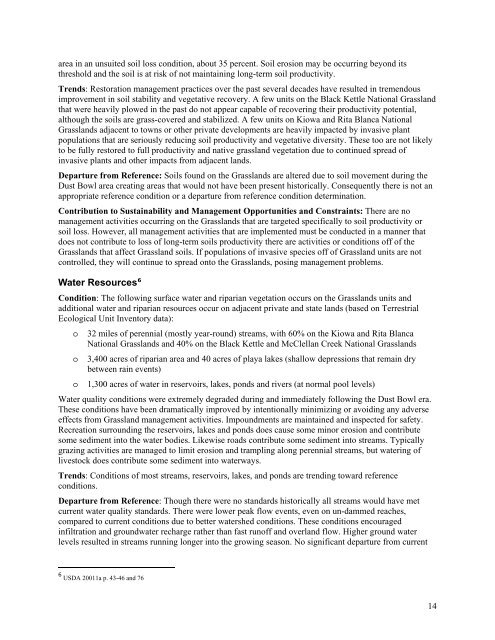Comprehensive Evaluation Report
Comprehensive Evaluation Report
Comprehensive Evaluation Report
You also want an ePaper? Increase the reach of your titles
YUMPU automatically turns print PDFs into web optimized ePapers that Google loves.
area in an unsuited soil loss condition, about 35 percent. Soil erosion may be occurring beyond its<br />
threshold and the soil is at risk of not maintaining long-term soil productivity.<br />
Trends: Restoration management practices over the past several decades have resulted in tremendous<br />
improvement in soil stability and vegetative recovery. A few units on the Black Kettle National Grassland<br />
that were heavily plowed in the past do not appear capable of recovering their productivity potential,<br />
although the soils are grass-covered and stabilized. A few units on Kiowa and Rita Blanca National<br />
Grasslands adjacent to towns or other private developments are heavily impacted by invasive plant<br />
populations that are seriously reducing soil productivity and vegetative diversity. These too are not likely<br />
to be fully restored to full productivity and native grassland vegetation due to continued spread of<br />
invasive plants and other impacts from adjacent lands.<br />
Departure from Reference: Soils found on the Grasslands are altered due to soil movement during the<br />
Dust Bowl area creating areas that would not have been present historically. Consequently there is not an<br />
appropriate reference condition or a departure from reference condition determination.<br />
Contribution to Sustainability and Management Opportunities and Constraints: There are no<br />
management activities occurring on the Grasslands that are targeted specifically to soil productivity or<br />
soil loss. However, all management activities that are implemented must be conducted in a manner that<br />
does not contribute to loss of long-term soils productivity there are activities or conditions off of the<br />
Grasslands that affect Grassland soils. If populations of invasive species off of Grassland units are not<br />
controlled, they will continue to spread onto the Grasslands, posing management problems.<br />
Water Resources 6<br />
Condition: The following surface water and riparian vegetation occurs on the Grasslands units and<br />
additional water and riparian resources occur on adjacent private and state lands (based on Terrestrial<br />
Ecological Unit Inventory data):<br />
o 32 miles of perennial (mostly year-round) streams, with 60% on the Kiowa and Rita Blanca<br />
National Grasslands and 40% on the Black Kettle and McClellan Creek National Grasslands<br />
o 3,400 acres of riparian area and 40 acres of playa lakes (shallow depressions that remain dry<br />
between rain events)<br />
o 1,300 acres of water in reservoirs, lakes, ponds and rivers (at normal pool levels)<br />
Water quality conditions were extremely degraded during and immediately following the Dust Bowl era.<br />
These conditions have been dramatically improved by intentionally minimizing or avoiding any adverse<br />
effects from Grassland management activities. Impoundments are maintained and inspected for safety.<br />
Recreation surrounding the reservoirs, lakes and ponds does cause some minor erosion and contribute<br />
some sediment into the water bodies. Likewise roads contribute some sediment into streams. Typically<br />
grazing activities are managed to limit erosion and trampling along perennial streams, but watering of<br />
livestock does contribute some sediment into waterways.<br />
Trends: Conditions of most streams, reservoirs, lakes, and ponds are trending toward reference<br />
conditions.<br />
Departure from Reference: Though there were no standards historically all streams would have met<br />
current water quality standards. There were lower peak flow events, even on un-dammed reaches,<br />
compared to current conditions due to better watershed conditions. These conditions encouraged<br />
infiltration and groundwater recharge rather than fast runoff and overland flow. Higher ground water<br />
levels resulted in streams running longer into the growing season. No significant departure from current<br />
6 USDA 20011a p. 43-46 and 76<br />
14
















